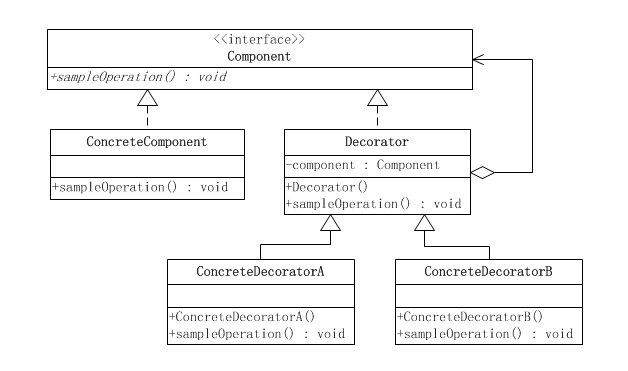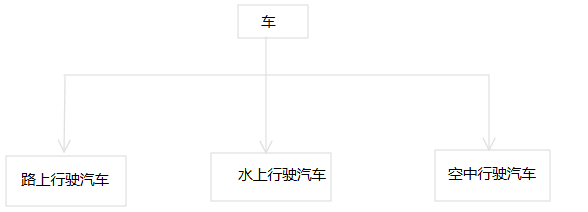转:http://blog.csdn.net/xu__cg/article/details/53024490
一、定义
装饰(Decorate)模式又称为包装(Wrapper)模式。装饰模式是以对客户端透明的方式扩展对象的功能,是继承关系的一个替代方案。
二、职责
- 动态的为一个对象增加新的功能。
- 装饰模式是一种用于代替继承的技术,无须通过继承增加子类就能扩展对象的新功能。使用对象的关联关系代替继承关系,更加灵活,同时避免类型体系的快速膨胀。
三、装饰模式结构
装饰模式类图:
- Component抽象构件角色:真实对象和装饰对象有相同的接口。这样,客户端对象就能够以与真实对象相同的方式同装饰对象交互。
- ConcreteCompoent具体构建角色(真实对象):定义一个将要接收附加责任的类。
- Decorator装饰角色:持有一个抽象构件的引用。装饰对象接受所有客户端的请求,并把这些请求转发给真实的对象。这样,就能在真实对象调用前后增加新的功能。
- ConcreteDecorate具体装饰角色:负责给构件对象增加新的功能。
四、简单的案例
举一个简单的汽车例子,创造每一种功能的汽车都需要继承车的父类进行实现如下图,那么当我们需要既能路上行驶有能水上行驶的车又得继续继承父类拓展新的类。
所以每增加一种新功能的汽车都需要新增一个类,这样的话就会创建大量的类。这时候就能使用装饰模式了。
代码示例:
抽象构件
- 1
- 2
- 3
- 4
- 1
- 2
- 3
- 4
具体构建
- 1
- 2
- 3
- 4
- 5
- 6
- 7
- 1
- 2
- 3
- 4
- 5
- 6
- 7
装饰角色
- 1
- 2
- 3
- 4
- 5
- 6
- 7
- 8
- 9
- 10
- 11
- 1
- 2
- 3
- 4
- 5
- 6
- 7
- 8
- 9
- 10
- 11
具体装饰 角色
- 1
- 2
- 3
- 4
- 5
- 6
- 7
- 8
- 9
- 10
- 11
- 12
- 13
- 14
- 15
- 16
- 17
- 18
- 19
- 20
- 21
- 22
- 23
- 24
- 25
- 26
- 27
- 28
- 29
- 30
- 31
- 32
- 33
- 34
- 35
- 36
- 37
- 38
- 39
- 40
- 41
- 42
- 43
- 44
- 45
- 1
- 2
- 3
- 4
- 5
- 6
- 7
- 8
- 9
- 10
- 11
- 12
- 13
- 14
- 15
- 16
- 17
- 18
- 19
- 20
- 21
- 22
- 23
- 24
- 25
- 26
- 27
- 28
- 29
- 30
- 31
- 32
- 33
- 34
- 35
- 36
- 37
- 38
- 39
- 40
- 41
- 42
- 43
- 44
- 45
客户端
- 1
- 2
- 3
- 4
- 5
- 6
- 7
- 8
- 9
- 10
- 11
- 12
- 13
- 14
- 15
- 16
- 17
- 18
- 19
- 20
- 21
- 22
- 23
- 24
- 25
- 26
- 27
- 28
- 29
- 30
- 31
- 32
- 33
- 34
- 35
- 36
- 1
- 2
- 3
- 4
- 5
- 6
- 7
- 8
- 9
- 10
- 11
- 12
- 13
- 14
- 15
- 16
- 17
- 18
- 19
- 20
- 21
- 22
- 23
- 24
- 25
- 26
- 27
- 28
- 29
- 30
- 31
- 32
- 33
- 34
- 35
- 36
由此可知,使用装饰模式就不用创建大量新的类而可以拓展出具有更多功能的对象了。
四、装饰模式在Java I/O库中的应用
IO流实现细节:
- Component抽象构件角色:io流中的InputStream,OutputStream,Reader,Writer
- ConcreteComponent具体构件角色:io流中的FileInputStream,FileOutputStream
- Decorate装饰角色:持有抽象构件的引用,FilterInputStream,FilterOutputStream
- ConcreteDecorate具体装饰角色:负责给构件对象添加新的责任,BufferedInputStream,BufferedOutputStream等
五、总结
- 装饰模式(Decorate)也叫包装模式(Wrapper)
- 装饰模式降低系统的耦合度,可以动态的增加或删除对象的责任,并使得需要装饰的具体构建类和具体装饰类可以独立变化,以便增加新的具体构建类和具体装饰类。
六、优点
- 扩展对象功能,比继承灵活,不会导致类个数急剧增加。
- 可以对一个对象进行多次装饰,创造出不同行为的组合,得到功能更加强大的对象。
- 具体构 件 类和具体装饰类可以独立变化,用户可以根据需要自己增加新的 具体构件子类和具体装饰子类。
七、缺点
- 产生很多小对象。大量小的对象占据内存,一定程度上影响性能。
- 装饰模式易出错,调试排查比较麻烦。
八、装饰模式与桥接模式区别
两个模式都是为了解决过多子类对象的问题。但他们的诱因不同,桥接模式是对象自身现有机制沿着多个维度变化,是既有部分不稳定。装饰模式是为了增加新的功能。
转:http://blog.csdn.net/jason0539/article/details/22713711
另外一个好例子
运行结果:
其实就是进房子找衣服,然后找地图这样一个过程,通过装饰者的三层装饰,把细节变得丰富。
关键点:
1、Decorator抽象类中,持有Human接口,方法全部委托给该接口调用,目的是交给该接口的实现类即子类进行调用。
2、Decorator抽象类的子类(具体装饰者),里面都有一个构造方法调用super(human),这一句就体现了抽象类依赖于子类实现即抽象依赖于实现的原则。因为构造里面参数都是Human接口,只要是该Human的实现类都可以传递进去,即表现出Decorator dt = new Decorator_second(new Decorator_first(new Decorator_zero(human)));这种结构的样子。所以当调用dt.wearClothes();dt.walkToWhere()的时候,又因为每个具体装饰者类中,都先调用super.wearClothes和super.walkToWhere()方法,而该super已经由构造传递并指向了具体的某一个装饰者类(这个可以根据需要调换顺序),那么调用的即为装饰类的方法,然后才调用自身的装饰方法,即表现出一种装饰、链式的类似于过滤的行为。
3、具体被装饰者类,可以定义初始的状态或者初始的自己的装饰,后面的装饰行为都在此基础上一步一步进行点缀、装饰。
4、装饰者模式的设计原则为:对扩展开放、对修改关闭,这句话体现在我如果想扩展被装饰者类的行为,无须修改装饰者抽象类,只需继承装饰者抽象类,实现额外的一些装饰或者叫行为即可对被装饰者进行包装。所以:扩展体现在继承、修改体现在子类中,而不是具体的抽象类,这充分体现了依赖倒置原则,这是自己理解的装饰者模式。
























 3561
3561











 被折叠的 条评论
为什么被折叠?
被折叠的 条评论
为什么被折叠?








